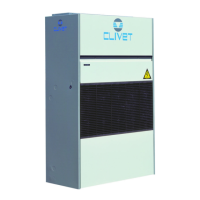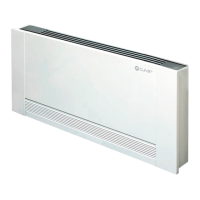Do you have a question about the CLIVET CF-V 31 and is the answer not in the manual?
| Brand | CLIVET |
|---|---|
| Model | CF-V 31 |
| Category | Touch terminals |
| Language | English |
Identifies the unit with a serial number label listing type, serial number, year of manufacture, etc.
Provides unique identification of the machine, enabling tracing of specific features and components.
Addresses fault handling, additional safety precautions, and intended use of the unit.
Highlights operational danger areas and safe handling procedures to prevent unit damage or injury.
Details risks associated with incorrect installation and electrical system vulnerabilities.
Describes various operational risks including contact with components, repairs, and panel security.
Outlines safe handling operations, critical points, and means of transport for the unit.
Provides specific guidelines for unit positioning, including indoor installation, safety valves, and avoiding flooding.
Details requirements for condensate discharge, including avoiding damage, making traps, and connecting to rainwater drains.
Provides advice to prevent freeze formation inside the coil, especially in low temperatures or abnormal conditions.
Emphasizes that electrical lines and components must be designed by specialists and installed by trained personnel.
Details the steps for connecting the unit to the mains power supply, including safety checks.
Lists essential checks before start-up, including installation conformity, power supply, and absence of tension.
Covers tightening electrical component screws, grounding, panel security, and verifying voltage/frequency limits.
Details operating modes (AUTOMATIC, MANUAL, ECO) and conditions for heating/cooling based on water temperature.
Covers modifying set points and managing fan speed between automatic and manual settings.
Lists and explains various alarm codes (RES, FES, BT1, BT2, BT3, H2O, SLF, CO, EHH, SYS, ERR, EUR) displayed by the unit.
Lists and explains alarm codes displayed by the terminal unit for various malfunctions.
Defines electric resistance operating modes (integration, main element) based on parameters and water temperature.
Details the importance of clean air filters for thermal exchange and outlines cleaning procedures for pleated filters.
Recommends annual or semi-annual inspections by authorized centers, covering power supply, electrical board, exchangers, and circuits.
Emphasizes identifying and eliminating alarm causes before resetting and checking electrical diagrams for safety interlocks.
Instructs on safe disconnection by authorized personnel, including recovery of refrigerant and antifreeze.
States the unit must be sent to authorized centers for dismantling and disposal, complying with national standards.











